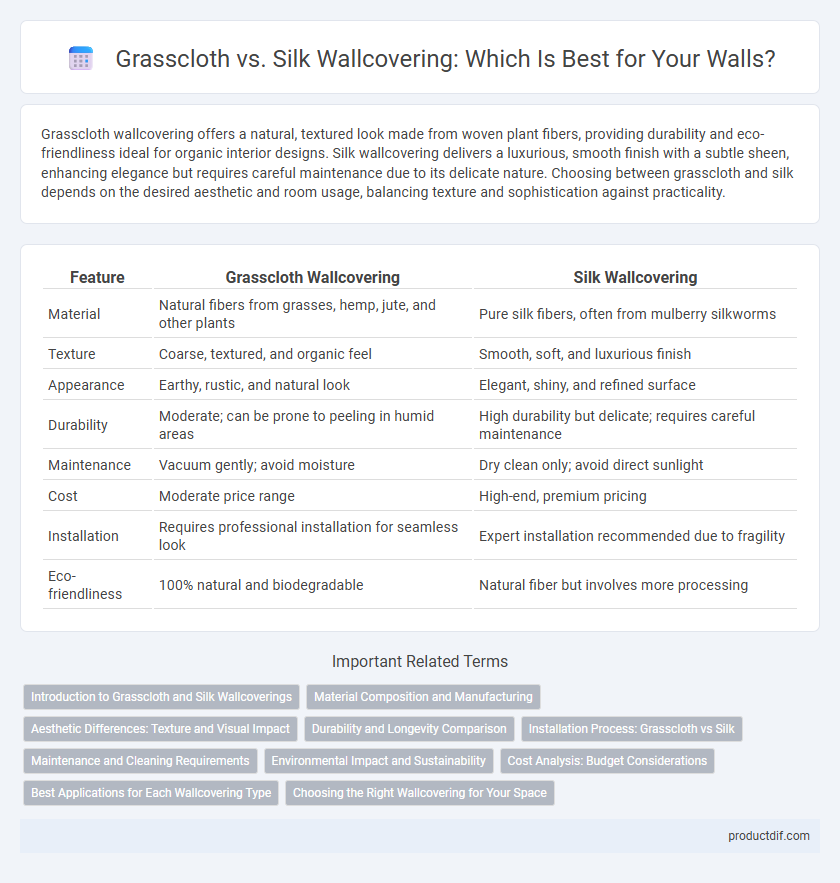Grasscloth wallcovering offers a natural, textured look made from woven plant fibers, providing durability and eco-friendliness ideal for organic interior designs. Silk wallcovering delivers a luxurious, smooth finish with a subtle sheen, enhancing elegance but requires careful maintenance due to its delicate nature. Choosing between grasscloth and silk depends on the desired aesthetic and room usage, balancing texture and sophistication against practicality.
Table of Comparison
| Feature | Grasscloth Wallcovering | Silk Wallcovering |
|---|---|---|
| Material | Natural fibers from grasses, hemp, jute, and other plants | Pure silk fibers, often from mulberry silkworms |
| Texture | Coarse, textured, and organic feel | Smooth, soft, and luxurious finish |
| Appearance | Earthy, rustic, and natural look | Elegant, shiny, and refined surface |
| Durability | Moderate; can be prone to peeling in humid areas | High durability but delicate; requires careful maintenance |
| Maintenance | Vacuum gently; avoid moisture | Dry clean only; avoid direct sunlight |
| Cost | Moderate price range | High-end, premium pricing |
| Installation | Requires professional installation for seamless look | Expert installation recommended due to fragility |
| Eco-friendliness | 100% natural and biodegradable | Natural fiber but involves more processing |
Introduction to Grasscloth and Silk Wallcoverings
Grasscloth wallcoverings are crafted from natural fibers like jute, hemp, or seagrass, offering textured and eco-friendly surfaces ideal for adding organic warmth to interiors. Silk wallcoverings feature luxurious, smooth textures with a subtle sheen, made from fine silk threads that provide elegance and a sophisticated aesthetic. Both types enhance spaces uniquely, with grasscloth emphasizing rustic charm and durability, while silk delivers refined opulence and delicate finish.
Material Composition and Manufacturing
Grasscloth wallcovering is crafted from natural fibers such as jute, hemp, and arrowroot, woven together to create a textured, organic surface. Silk wallcovering comprises fine silk threads, often handwoven or machine-produced, offering a smooth, luxurious finish with a delicate sheen. The manufacturing of grasscloth emphasizes eco-friendly, sustainable practices through natural fiber extraction and weaving, while silk wallcovering production requires meticulous sericulture and delicate weaving techniques to preserve fabric quality and luster.
Aesthetic Differences: Texture and Visual Impact
Grasscloth wallcovering offers a natural, textured surface with visible fibers that create an organic, earthy aesthetic, ideal for adding warmth and depth to interior spaces. Silk wallcovering provides a smooth, lustrous finish that reflects light subtly, enhancing elegance and sophistication with a luxurious visual impact. Choosing between grasscloth and silk depends on desired ambiance--rustic and tactile versus refined and glossy.
Durability and Longevity Comparison
Grasscloth wallcovering offers high durability due to its natural fiber composition, resisting wear and tear in high-traffic areas while maintaining texture and appearance over time. Silk wallcovering, though luxurious and elegant, is less durable and prone to fading, staining, and damage from moisture, making it best suited for low-traffic, controlled environments. The longevity of grasscloth surpasses silk, as its robust fibers withstand environmental stress better, ensuring lasting beauty with minimal maintenance.
Installation Process: Grasscloth vs Silk
Grasscloth wallcovering requires careful handling during installation due to its natural fiber composition, necessitating precise alignment and seam matching to prevent visible joints. Silk wallcovering demands meticulous preparation of the smooth surface and skilled application to avoid puckering and ensure even adhesion, as its delicate texture is prone to damage. Both materials often require professional installation to achieve optimal results and maintain their luxurious appearance.
Maintenance and Cleaning Requirements
Grasscloth wallcoverings require gentle maintenance with vacuuming or dry brushing to prevent damage to their natural fibers, as they are sensitive to moisture and stains. Silk wallcoverings demand careful cleaning with a soft, dry cloth and occasional professional cleaning to preserve their delicate texture and sheen, avoiding water or harsh chemicals. Both materials need spot treatment and preventive care to maintain their appearance, but silk generally requires more specialized upkeep to prevent discoloration and damage.
Environmental Impact and Sustainability
Grasscloth wallcovering, made from natural fibers like hemp, jute, and seagrass, offers a renewable and biodegradable option that supports sustainable harvesting practices. Silk wallcovering, while luxurious and durable, involves intensive water and energy use in silk production along with ethical concerns related to silkworm farming. Choosing grasscloth can reduce environmental impact due to its lower carbon footprint and eco-friendly sourcing compared to the resource-intensive process of producing silk wallcoverings.
Cost Analysis: Budget Considerations
Grasscloth wallcovering offers an affordable option with prices typically ranging from $30 to $60 per roll, making it suitable for budget-conscious projects. Silk wallcovering, known for its luxurious texture and vibrant sheen, commands a higher price, often between $100 and $300 per roll, reflecting the cost of natural silk fibers and complex manufacturing. When choosing between grasscloth and silk, evaluating installation expenses and durability can further influence overall budget planning for wallcovering projects.
Best Applications for Each Wallcovering Type
Grasscloth wallcovering is ideal for high-traffic areas such as living rooms and hallways due to its durability and natural texture that adds warmth and depth. Silk wallcovering excels in low-traffic, formal spaces like dining rooms and bedrooms, providing a luxurious sheen and sophisticated ambiance. Choosing grasscloth enhances rustic or casual decor, while silk complements elegant, traditional interiors requiring delicate maintenance.
Choosing the Right Wallcovering for Your Space
Grasscloth wallcovering offers a natural, textured aesthetic with eco-friendly properties, ideal for adding warmth and organic appeal to living rooms or bedrooms. Silk wallcovering provides a luxurious, smooth finish with subtle sheen, enhancing formal spaces like dining rooms or offices with elegance and sophistication. Selecting between grasscloth and silk depends on desired ambiance, durability requirements, and budget considerations for your specific interior design goals.
Grasscloth vs Silk Wallcovering Infographic

 productdif.com
productdif.com